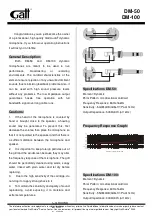
4
Applications
The following table provides basic recording techniques for several sources. Experiment with various configurations and microphone
placement to achieve the preferred sound.
Source
Suggested Microphones
Tips
Drums
PGA181: Stereo overheads
PGA52: Kick drum
PGA57: Snare Drum
• See stereo microphone techniques for overhead placement options
• If the kick drum resonant head has a hole in it, place the microphone inside
for improved isolation from other instruments
• Aim the PGA57 towards the center of the snare drum head to capture more
stick attack, or closer the edge to capture more overtones.
Vocals
PGA181
• Place the microphone 1-6 inches (2-15 cm) from the source
• Use a pop filter (Shure PS-6) to prevent plosives
Acoustic Guitar
PGA181
• Use two PGA181 microphones to record in stereo using one of the stereo
recording methods, or a single PGA181 for a mono signal
• Place microphone(s) 6-12 inches (15-30 cm) from the guitar
• Place near the 12th fret for a balanced sound, or closer to the sound hole
for more bass
Full Band
PGA181: Stereo pair, aimed
at entire group
PGA52: Kick drum or bass
amplifier
PGA57: Vocals or guitar
amplifier
• Use close-placement microphones on sources that are most likely to need
extra volume in the mix, such as vocals or acoustic instruments.
• If more close-placement microphones are necessary, use one PGA181 to
capture the entire group, and use the second PGA181 on an instrument.
Guitar/Bass
Amplifiers
PGA52: Bass amplifier
PGA57: Guitar amplifier
PGA181: Guitar or bass
amplifiers
• Aim the microphone at the center of the speaker cone for a bright, punchy
sound, or towards the edge of the speaker for a mellow sound.
• The PGA181 delivers a clear, detailed sound
• The PGA57 and PGA52 deliver a warmer sound that helps to smooth out
harsh sounding amplifiers
Advanced tip: For a more spacious sound, use a PGA57 or PGA52 close to
the amp, with a PGA181 placed 10-20 feet away. Pan them slightly in opposite
channels to create a full, roomy sound.
Strings
PGA181: Stereo pair
(ensemble), any individual
instrument
• To record a string ensemble, use one of the stereo microphone techniques
to capture the width of the source
• For an individual instrument, try using one PGA181 approximately 1 foot
from the source, with the other PGA181 in the room (6-12 feet from the
source) to capture ambience.
Brass and
Woodwinds
PGA181: Stereo pair
(ensemble), any individual
instrument
PGA52: Tuba
PGA57: Saxophone, trumpet,
trombone
• To capture brass and woodwind ensembles, use one of the stereo
microphone techniques to capture the width of the source
• For an individual instrument, such as a saxophone, aim the PGA57 toward
the bell of the instrument and use a PGA181 in the room (6-12 feet from
the source) to capture ambience
• For a simplified approach, simply use one PGA181 placed 1-2 feet from the
instrument
Piano
PGA181 (Stereo pair)
• Use a stereo recording technique, with the microphones placed inside the
piano lid
• For upright pianos, keep the top open and/or remove the front panel when
possible
Summary of Contents for PGA STUDIO MICROPHONE KIT
Page 7: ......

























